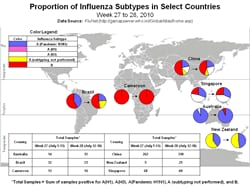Note: Today is my last full day of my mini vacation, so a brief entry and unless there’s some breaking news, I may not update this blog again until my return Sunday.
# 4788
The World Health Organization (WHO) reports this week that the levels of pandemic and seasonal flu activity were most pronounced in parts of South Asia and limited areas of tropical South and Central America.
India continues to report significant numbers of H1N1 cases, although it does not appear to be as bad as during the peak of their pandemic wave in 2009.
Pandemic (H1N1) 2009 - update 112
(EXCERPT)
In the temperate zone of the southern hemisphere, overall seasonal and pandemic influenza activity remains low, except in South Africa, where peak wintertime influenza transmission due to circulating seasonal influenza viruses (H3N2 and type B) might have recently occurred.
Seasonal influenza viruses, particularly H3N2 viruses, continue to circulate in parts of Central America, East Africa, and Southeast Asia.
From the WHO’s Weekly Virological Update , we get a snapshot of the circulation of viruses in the Southern Hemisphere in 2010.
The CDC’s International Flu Activity Update describes the situation this way.
2009 H1N1 Flu: International Situation Update
This report provides an update to the international flu situation using data collected through July 25, 2010, and reported by the World Health Organization (WHO) on July 30.
Global Flu Activity Update
WHO continues to report laboratory-confirmed 2009 H1N1 flu deaths on its Web page. These fatal cases are an under-representation of the actual numbers, as many deaths are never tested or recognized as flu related.
Overall, flu activity due to 2009 H1N1 and seasonal flu viruses is low worldwide. However, some tropical regions, such as areas of the Americas and South and Southeast Asia, continue to report high levels of flu activity related to seasonal flu or 2009 H1N1. In the Northern Hemisphere, flu activity has been low or sporadic.
Southern Hemisphere
In the Southern Hemisphere, levels of flu activity vary by location. There is low, but increasing, flu activity in Australia and New Zealand. In Australia, 2009 H1N1 is the most common virus strain, followed by influenza A (H3N2) viruses.
Virologic data from South Africa suggests flu activity has peaked, but remains elevated, mostly due to seasonal influenza B and A (H3N2) viruses. Overall, levels of influenza-like illness (ILI) in Chile remain low, except in the Los Lagos region. The majority of flu viruses in Chile and Argentina are 2009 H1N1 and seasonal B viruses. In tropical regions of the Americas, 2009 H1N1 and seasonal flu virus activity was reported in early July.
Asia
In Asia, India reported the most 2009 H1N1 activity. Low levels of 2009 H1N1 activity were also detected in several Southeast Asia countries, including Cambodia, Singapore and Malaysia. Singapore continues to report high levels of seasonal A (H3N2) activity.
Africa
In Sub-Saharan Africa, seasonal A (H3N2) and B viruses continue to circulate in parts of Kenya and central Africa (Cameroon), and pandemic flu transmission continues in Ghana.
Selected Highlights
- According to WHO, the majority of 2009 H1N1 virus isolates tested worldwide remains sensitive to oseltamivir, an antiviral medicine used to treat flu. Among 2009 H1N1 isolates tested worldwide, 302 have been found to be resistant to oseltamivir as of July 21st. Approximately 1% of U.S. 2009 H1N1 viruses tested by CDC since September 1, 2009, have been resistant to oseltamivir.
- Globally 50.7% of subtyped influenza A viruses were 2009 H1N1, according to WHO data collected from July 11-17, 2010, and reported on July 28.
Related Post:
Widget by [ Iptek-4u ]


